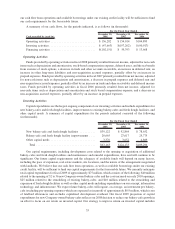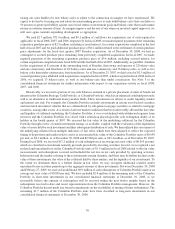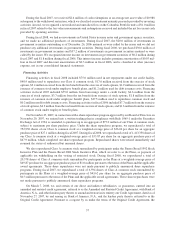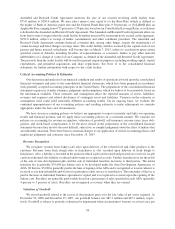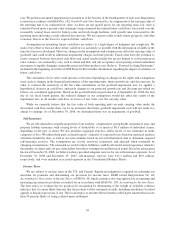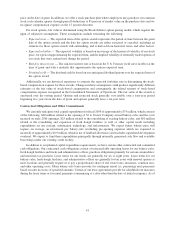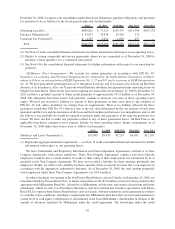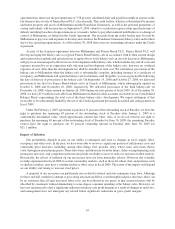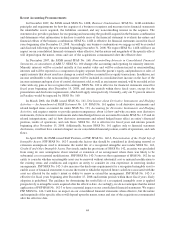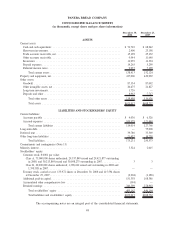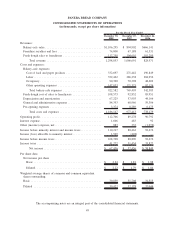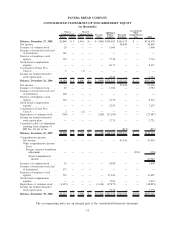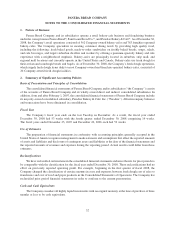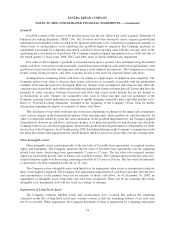Panera Bread 2008 Annual Report Download - page 52
Download and view the complete annual report
Please find page 52 of the 2008 Panera Bread annual report below. You can navigate through the pages in the report by either clicking on the pages listed below, or by using the keyword search tool below to find specific information within the annual report.In June 2008, the FASB issued FSP Emerging Issues Task Force, or EITF, No. 03-6-1, Determining Whether
Instruments Granted in Share-Based Payment Transactions Are Participating Securities. According to FSP EITF
No. 03-6-1, unvested share-based payment awards that contain nonforfeitable rights to dividends or dividend
equivalents are considered participating securities under SFAS No. 128, Earnings per Share. As such, they should
be included in the computation of basic earnings per share, or EPS, using the two-class method. FSP EITF
No. 03-6-1 is effective for financial statements issued for fiscal years beginning after December 15, 2008, as well as
interim periods within those years. Once effective, all prior-period EPS data presented must be adjusted retro-
spectively. We do not expect FSP EITF No. 03-6-1 to have a material impact on our financial position or results of
operations.
In November 2008, the FASB ratified EITF No. 08-7, Accounting for Defensive Intangible Assets. EITF
No. 08-7 applies to defensive intangible assets, which are acquired intangible assets that the acquirer does not intend
to actively use but intends to hold to prevent its competitors from obtaining access to them. As these assets are
separately identifiable, EITF No. 08-7 requires an acquiring entity to account for defensive intangible assets as a
separate unit of accounting, which should be amortized to expense over the period the asset diminished in value.
Defensive intangible assets must be recognized at fair value in accordance with SFAS No. 141R and SFAS No. 157.
EITF No. 08-7 is effective for financial statements issued for fiscal years beginning after December 15, 2008. We
expect EITF No. 08-7 will have an impact on our consolidated financial statements when effective, but the nature
and magnitude of the specific effects will depend upon the nature, terms and size of the intangible assets purchased
after the effective date.
ITEM 7A. QUANTITATIVE AND QUALITATIVE DISCLOSURES ABOUT MARKET RISK
Commodity Risk
We manage our commodity risk in several ways. On occasion, we have entered into swap agreements to
manage our fluctuating butter prices. All derivative instruments are entered into for other than trading purposes. In
fiscal 2008 and 2007, we did not have any derivative instruments. In addition, we purchase certain commodities,
such as flour, coffee and proteins, for use in our business. These commodities are sometimes purchased under
agreements of one month to one year time frames usually at a fixed price. As a result, we are subject to market risk
that current market prices may be above or below our contractual price.
Interest Rate Sensitivity
We are also exposed to market risk primarily from fluctuations in interest rates on our revolving credit facility.
Our revolving credit facility provides for a $250.0 million secured facility under which we may select interest rates
equal to (1) the Base Rate (which is defined as the higher of the Bank of America prime rate and the Federal funds
rate plus 0.50 percent) or (2) LIBOR plus an applicable rate ranging from 0.75 percent to 1.50 percent as set forth in
the Amended and Restated Credit Agreement. We did not have an outstanding balance on our borrowings at
December 30, 2008. We may have future borrowings under our credit facility, which could result in an interest rate
change that may have an impact on our results of operations.
Foreign Currency Exchange Risk
In the fourth quarter of fiscal 2008, we expanded our operations into Canadian markets by opening two
franchise-operated bakery-cafes. Our operating expenses and cash flows are subject to fluctuations due to changes
in the exchange rate of the Canadian Dollar, in which our operating obligations in Canada are paid. To date, we have
not entered into any hedging contracts, although we may do so in the future. Fluctuations in currency exchange rates
could affect our business in the future.
45


